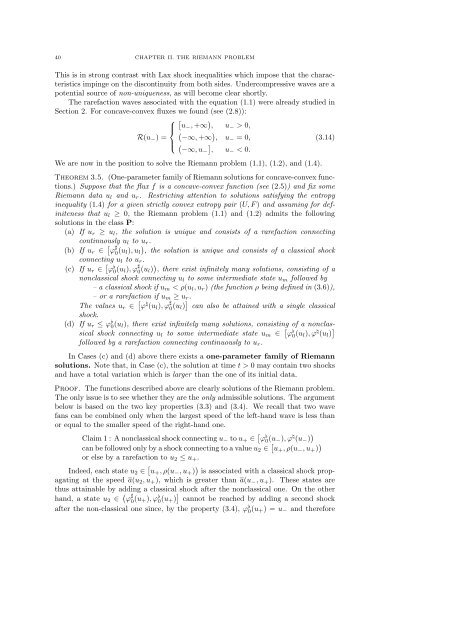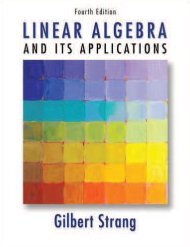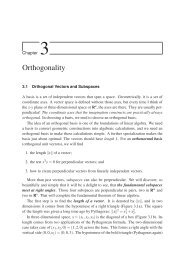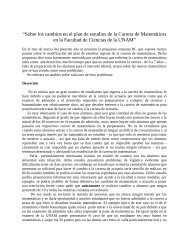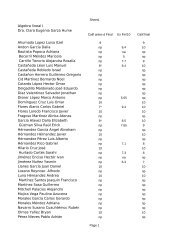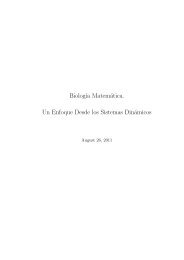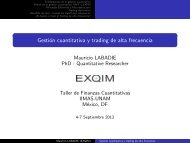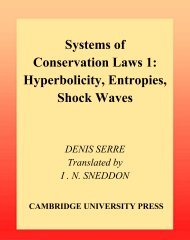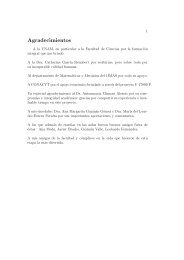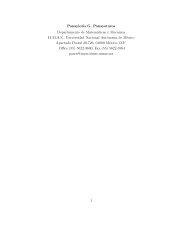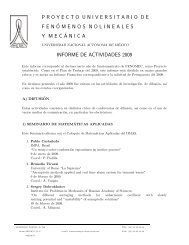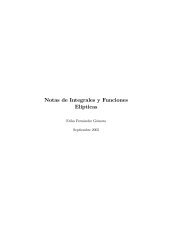Order Form - FENOMEC
Order Form - FENOMEC
Order Form - FENOMEC
Create successful ePaper yourself
Turn your PDF publications into a flip-book with our unique Google optimized e-Paper software.
40 CHAPTER II. THE RIEMANN PROBLEM<br />
This is in strong contrast with Lax shock inequalities which impose that the characteristics<br />
impinge on the discontinuity from both sides. Undercompressive waves are a<br />
potential source of non-uniqueness, as will become clear shortly.<br />
The rarefaction waves associated with the equation (1.1) were already studied in<br />
Section 2. For concave-convex fluxes we found (see (2.8)):<br />
⎧ [<br />
⎪⎨ u− , +∞ ) , u − > 0,<br />
( )<br />
R(u − )= −∞, +∞ , u− =0,<br />
(3.14)<br />
⎪⎩ ( ]<br />
−∞,u− , u− < 0.<br />
We are now in the position to solve the Riemann problem (1.1), (1.2), and (1.4).<br />
Theorem 3.5. (One-parameter family of Riemann solutions for concave-convex functions.)<br />
Suppose that the flux f is a concave-convex function (see (2.5)) andfixsome<br />
Riemann data u l and u r . Restricting attention to solutions satisfying the entropy<br />
inequality (1.4) for a given strictly convex entropy pair (U, F ) and assuming for definiteness<br />
that u l ≥ 0, the Riemann problem (1.1) and (1.2) admits the following<br />
solutions in the class P:<br />
(a) If u r ≥ u l , the solution is unique and consists of a rarefaction connecting<br />
continuously u l to u r .<br />
(b) If u r ∈ [ ϕ ♯ 0 (u )<br />
l),u l , the solution is unique and consists of a classical shock<br />
connecting u l to u r .<br />
(c) If u r ∈ [ ϕ ♭ 0(u l ),ϕ ♯ 0 (u l) ) , there exist infinitely many solutions, consisting of a<br />
nonclassical shock connecting u l to some intermediate state u m followed by<br />
–aclassicalshockifu m 0 may contain two shocks<br />
and have a total variation which is larger than the one of its initial data.<br />
Proof. The functions described above are clearly solutions of the Riemann problem.<br />
The only issue is to see whether they are the only admissible solutions. The argument<br />
below is based on the two key properties (3.3) and (3.4). We recall that two wave<br />
fans can be combined only when the largest speed of the left-hand wave is less than<br />
or equal to the smaller speed of the right-hand one.<br />
Claim 1 : A nonclassical shock connecting u − to u + ∈ [ ϕ ♭ 0(u − ),ϕ ♮ (u − ) )<br />
can be followed only by a shock connecting to a value u 2 ∈ [ u + ,ρ(u − ,u + ) )<br />
or else by a rarefaction to u 2 ≤ u + .<br />
Indeed, each state u 2 ∈ [ u + ,ρ(u − ,u + ) ) is associated with a classical shock propagating<br />
at the speed a(u 2 ,u + ), which is greater than a(u − ,u + ). These states are<br />
thus attainable by adding a classical shock after the nonclassical one. On the other<br />
hand, a state u 2 ∈ ( ϕ ♯ 0 (u +),ϕ ♭ 0(u + ) ] cannot be reached by adding a second shock<br />
after the non-classical one since, by the property (3.4), ϕ ♭ 0(u + )=u − and therefore


